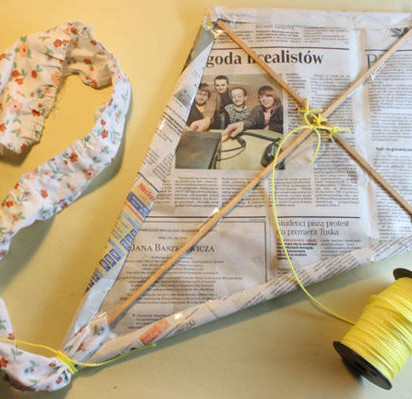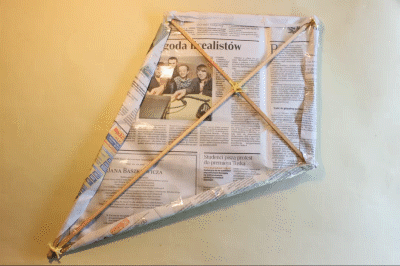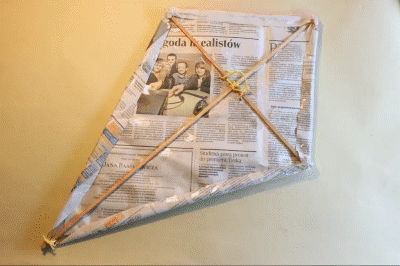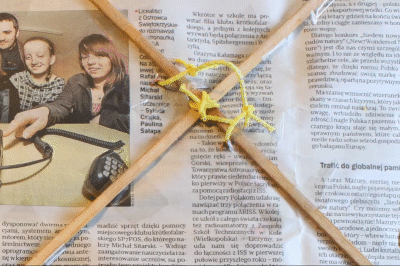How to make a Diamond Kite
A diamond-shaped kite is easy to make and will fly in even the lowest wind speeds. These instructions will show you how to make a simple diamond shaped kite from paper. There are more complex designs available, but this easy-to-build model will still bring you hours of kite-flying fun!
You will need:
- Lightweight drawing paper or newspaper
- Lightweight wood dowels (avoid balsa wood; it’s very weak)
- String (the thinner/lighter the better; fishing line is good)
- Scissors
- Tape
- Keel (optional)

Step 1
Make sure that you are familiar with the terms typically used to describe a kite’s structure. See the Tips section below if you want to brush up on your kite vocabulary.

Step 2
Take a big piece of lightweight drawing paper or newspaper and draw a perfect square on it.

Cut out the square using scissors or an art knife.

Step 3
Open the paper and place your wooden dowel vertically on the fold line to make the spine. For this, you can use two straight sticks made of wood or bamboo, or wooden doweling.

If your sticks are of different lengths, use the longer one as the spine (vertically) and the shorter one(s) as the spar (horizontally).

Step 4
Place another dowel horizontally across the first dowel above the centre of the paper to make the spar, forming 90-degree angles with the spine. Make sure that the spine runs exactly through the centre of the spar, so that it’s equal widths on both sides of the spine.

Secure the two dowels together by reinforcing the intersecting area with string and tape. You may also want to use a glue gun or superglue to ensure that the frame is securely attached.

Step 5
Place dowels along the edges and attach them securely to the paper. Alternatively, tie strings to the two main dowels and connecting all corners along the edges. Glue and tape string into folded edges. Cut off all the excess paper.


Step 6
After you’ve secured the kite structure, reinforce the kite by adding more tape to the edges and centre of the kite.


Step 7
Make two holes in the tape holding the vertical dowel in the middle, a few inches above the centre point to prepare to tie a string to the dowel.

Next, use the same method to make two more holes below the centre line.

Step 8
Feed a string through both sets of holes and tie them to the dowel on each end leaving a little slack, creating the keel of the kite.


Step 9
Use a strip of cloth attached to the bottom of the kite to make a tail for the kite. This helps the kite to fly with added stability. (If you would like, bow the vertical cross stick back a little with a “bow string.”)


Step 10
Tie a long string to the keel string, which you will hold to control and fly your kite. You may have it rolled up on a piece a wooden broom handle. Now your creation is ready to fly!


Step 11
Finished!

Handy Tips
- You should be able to get dowels or narrow sticks from any arts & crafts shop.
- The larger your paper, the better your kite flies.
- The heavier your materials, the more wind will be needed to get the kite up in the air.
- Be careful to keep your kite away from trees, or it may get stuck.
- Do not fly close to power lines as they will damage the kite and possibly even electrocute you if the string were wet.
- Do not try flying the kite in the rain, as the paper may tear.
- Pay attention to the weather; you don’t want to be struck by lightning!
Kite Terminology
Familiarise yourself with the structure of a kite:
- Spine: The vertical bar that a kite is built around.
- Spar: The support stick(s) placed perpendicular or slanted over the spine for horizontal support. These can be curved or bowed.
- Frame: The kite’s support structure, formed by the spine and spar attached together with string and/or tape.
- Cover: The paper, plastic, or cloth used to cover the frame for the body of the kite.
- Bridle: The string(s) attached to the spine or spars, used to control the kite in the air.
- Flying Line: The string running from the bridle that you hold to fly the kite.
- Tail (optional): A strip of paper or plastic that balances the kite in flight.
- Reel: The object used to hold and reel in the flying line.
- Keel: A strip of sail-like material that hangs under the kite to help stabilise it in flight. If present, you can attach the flying line to here instead of the bridle.
With thanks to Pure Magic Dublin and wikiHow. Please edit this article and find author credits at the original wikiHow article on How to make a Diamond Kite. Content on wikiHow can be shared under a Creative Commons License.


